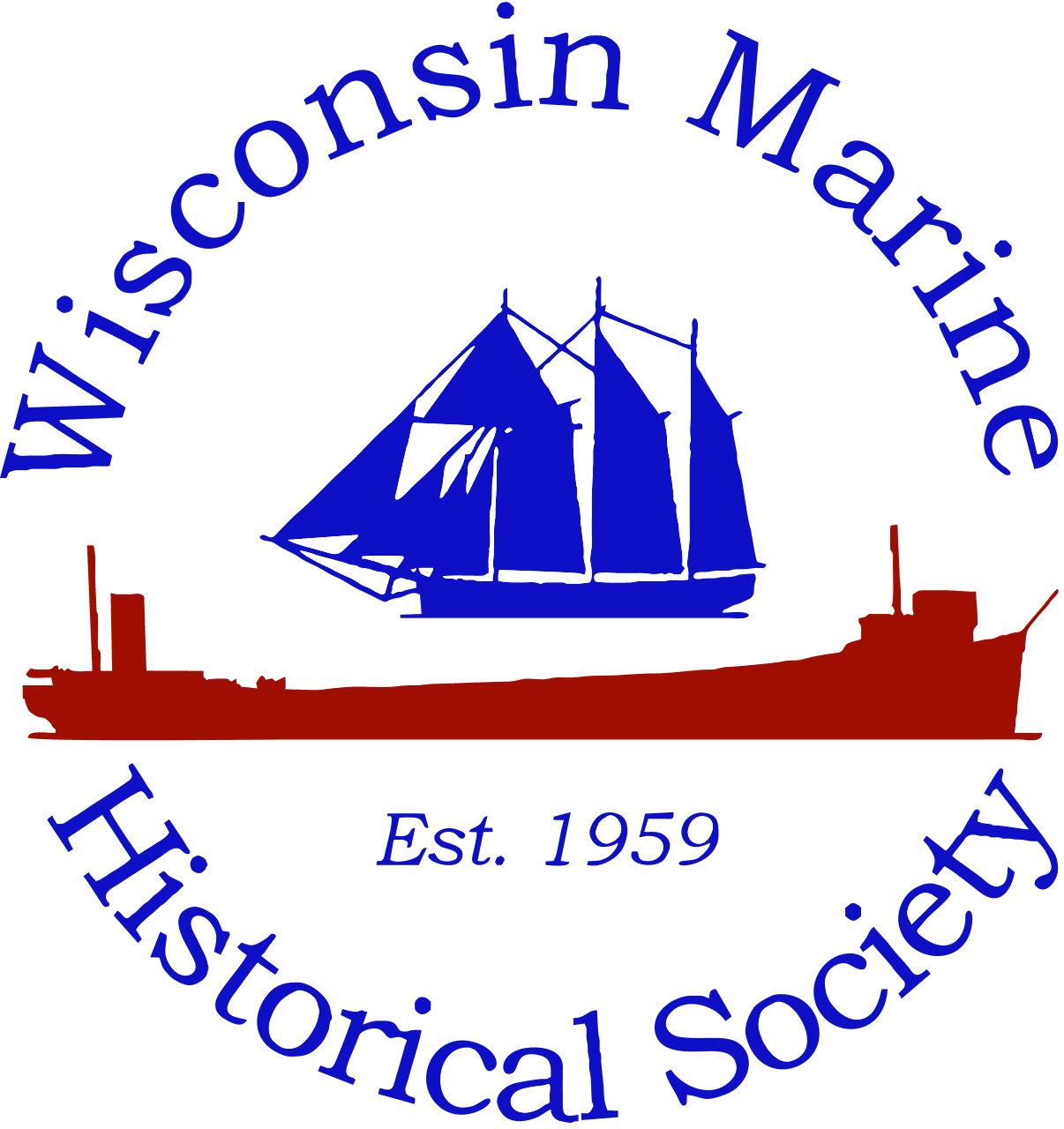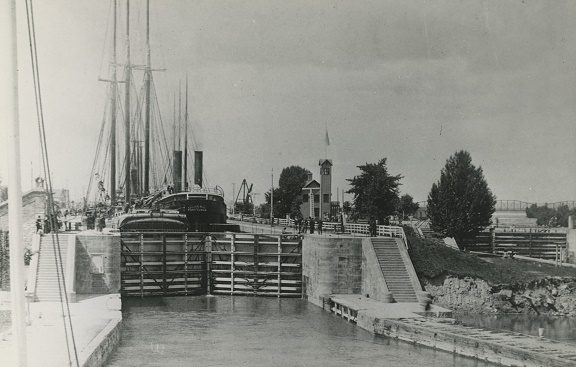By James Heinz
(Steinbrenner Story – Chapter Four)
Sophia Minch already knew the dangers of Lake Michigan. The schooner named after her was wrecked in the surf on her native Cleveland lakefront in full view of a crowd of thousands, and possibly her as well.
The wooden schooner SOPHIA MINCH was launched in 1873 at Vermillion, Ohio. She displaced 583 tons, was 180 feet long and 32 feet wide and had three masts.
On October 31, 1883, the Gales of November came early for the SOPHIA MINCH. According to WMHS files, at 7 pm that night the SOPHIA MINCH and her crew of eight arrived off her home port of Cleveland with a load of iron ore. The MINCH arrived in the middle of “a northwesterly gale with a rough and dangerous sea”, which disabled her rudder. She dropped both anchors off the east pier and hoisted a signal requesting assistance.
The tug PETER SMITH responded, with two members of the Cleveland lifesaving station aboard. The captain of the SOPHIA MINCH refused to pull up his anchors because he felt that two tugs would not be enough to tow him in, and request an additional tug respond.
The PETER SMITH went back into the harbor and returned with the tug FANNY TUTHILL. The rest of the local lifesaving crew jumped on board the PETER SMITH. When they arrived back at the SOPHIA MINCH all but one of the lifesavers jumped on board the MINCH and helped connect the tow lines to the tugs.
The tugs began towing the SOPHIA MINCH to shelter behind the breakwater, but both tow lines parted. The schooner then drifted in the storm to the east of the harbor piers. The two tugs had no choice but to shelter behind the breakwater.
The schooner began drifting toward the rocky shore. She was taking on water in the hold faster than the men could pump and had water washing over her deck. The captain decided to scuttle his ship on the sandy bottom where she would suffer less damage than she would if she went on the rocks. This was accomplished by boring holes in the forward deck with an auger and letting the hold fill with water until the ship settled on the bottom.
The crew and the lifesavers then climbed into the rigging to wait out the storm. By this time it was 2 in the morning. Two of the lifesavers who had remained on shore rounded up a crew of volunteers, including a customs inspector, a lighthouse keeper and three civilian volunteers, one of whom used his team of horses to pull the cart containing the surf rescue equipment to the scene.
The Lyle gun was set up and fired a line towards the sunken schooner. The first shot landed in the rigging of the foremast and the breeches buoy was set up and winched out to the men in the rigging. The lifesaving station master came ashore first, followed by all but one of the men stranded in the foremast.
There were two men stranded in the rigging of the mizzen mast, the mast furthest to the rear. Frederick Hatch, one of the surfmen from the foremast who had come ashore volunteered to be sent back to the foremast via the breeches buoy. He then told the man who had remained in the foremast that he would try to make it back to the mizzenmast but if he did not return in time the rescue crew should abandon him

In the words from the WMHS files, Hatch “was literally taking his life in his hands” in this “extremely hazardous undertaking.” Hatch made it to the mizzen rigging but was unable to return to the foremast. As agreed, the surf crew brought the last man back from the foremast and disconnected the rescue line and repositioned the line throwing cannon and fired another line at the mizzen mast. This was successful and the remaining men from the mizzen mast were brought ashore by breeches buoy, Hatch being the last to leave the sunken ship.
On November 4th the SOPHIA MINCH was pumped out and brought into the harbor to be repaired and returned to service as a barge. All eight of the men from the lifesaving service received a well-deserved gold Lifesaving Medal.
It is not known if Sophia Minch saw the wreck of her namesake ship, although she was alive and living in Cleveland at the time and if she did not, she was probably the only person in Cleveland who didn’t.
This was not the SOPHIA MINCH’s last experience being driven ashore in a storm. On 1899 she was being towed by the steamer JOHN N. GLIDDEN when a storm came up. The steamer cut the MINCH loose and she was blown ashore 10 miles west of Ashtabula, where she was declared a total loss but salvaged in 1900. She was sold to Canadian owners in 1907 and remained in service until 1920 when she was abandoned. She was towed out into Lake Ontario in 1927 and scuttled.
After Peter Minch died in 1890, his son Philip Jacob Minch II (1867-1944) ran the Minch Transit Company in 1893 in association with his aunt Sophia Minch and his grandmother Anna C. Minch. Anna C. Minch was vice-president of the Minch Transit Company, and president of the Nicholas Transit Company.
NEXT: HENRY STEINBRENNER I, GORDON LIGHTFOOT, AND THE WRECK OF THE HENRY STEINBRENNER I
Photo at top of page: SOPHIA MINCH (built 1873) in the lock.
Photo Credit: Great Lakes Marine Collection of the Milwaukee Public Library and Wisconsin Marine Historical Society.
____________________________________
James Heinz is the Wisconsin Marine Historical Society’s acquisitions director. He became interested in maritime history as a kid watching Jacques Cousteau’s adventures on TV. He was a Great Lakes wreck diver until three episodes of the bends forced him to retire from diving. He was a University of Wisconsin – Milwaukee police officer for thirty years. He regularly flies either a Cessna 152 or 172.
GEORGE STEINBRENNER, GREAT LAKES SHIP OWNER – Chapter One
THE WRECK OF THE WESTERN RESERVE – Chapter Two
NUTTY PHIL AND THE WRECK OF THE ONOKO – Chapter Three
SOPHIA MINCH AND THE WRECK OF THE SOPHIA MINCH – Chapter Four
HENRY STEINBRENNER I, GORDON LIGHTFOOT, AND THE WRECK OF THE HENRY STEINBRENNER I – Chapter Five
THE WRECK OF THE ANNA C. MINCH – Chapter Six
HENRY STEINBRENNER II AND THE SHIPWRECK THAT BECAME A SHIP AGAIN – Chapter Seven
AN OLDIE BUT A GOLDIE: HENRY STEINBRENNER II AND THE J. B. FORD – Chapter Eight
HENRY III AND GEORGE STEINBRENNER III: LIKE FATHER LIKE SON – Chapter Nine
KINSMAN TRANSIT IS IN TROUBLE – Chapter Ten
GEORGE III SAVES KINSMAN TRANSIT – Chapter Eleven
GEORGE III SAVES AMERICAN SHIPBUILDING – Chapter Twelve

